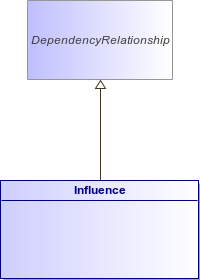
ArchiMate Metamodel
The influence relationship is used to describe that some architectural element influences achievement or implementation of a motivation element, such as a goal or a principle.
In general, a motivation element is realized to a certain degree. For example, consistently satisfying the principle 'serve customers wherever they are' will help making the goal 'increase market share' come true. In other words, the principle contributes to the goal. In turn, to implement the principle 'serve customers wherever they are', it may be useful to impose a requirement of '24x7 web availability' on some customer-facing application component. This can be modeled as a requirement that has a positive influence on that principle, and as an application component that in turn influences the requirement. Consistently modeling these dependencies with an influence relationship yields a traceable motivational path that explains why (in this example) a certain application component contributes to the corporate goal to 'increase market share'. This kind of traceability supports measuring the results of Enterprise Architecture, and provides valuable information to, for example, change impact assessments.
Additional to this 'vertical' use of contribution, from core elements upwards to requirements and goals, the relationship can also be used to model 'horizontal' contributions between motivation elements. The influence relationship in that case describes that some motivation element may influence (the achievement or implementation of) another motivation element. In general, a motivation element is achieved to a certain degree. An influence by some other element may affect this degree positively or negatively, depending on the degree in which this other element is satisfied itself. For example, the degree in which the goal to increase customer satisfaction is realized may be represented by the percentage of satisfied customers that participate in a market interview. This percentage may be influenced positively by, for example, the goal to improve the reputation of the company; i.e., a higher degree of improvement results in a higher increase in customer satisfaction. On the other hand, the goal to lay off employees may influence the company reputation negatively; i.e., more lay-offs could result in a lower increase (or even decrease) in the company reputation. And thus (indirectly), the goal to increase customer satisfaction may also be influenced negatively.
An important difference between the realization and influence relationships is that, whereas the realization relationship implies full realization of the relationship's target, the influence relationship does not have this implication. In other words, while a positive influence (on a goal, principle, requirement, etc.) is useful - and perhaps even necessary - it may very well not be sufficient for its achievement or implementation. Moreover, the influence relationship can be used to model either:
- The fact that an element positively contributes to the achievement or implementation of some motivation element, or
- The fact that an element negatively influences - i.e., prevents or counteracts - such achievement
Attributes can be used to indicate the sign and/or strength of the influence. The choice of possible attribute values is defined in the InfluenceStength enumeration. By default, the influence relationship models an undefined contribution with unquantified strength.

Attribute | Description |
|---|---|
string strength [1..1] | Indicates the sign and strength of the influence. A choice of possible attribute values is defined in the InfluenceStrength enumeration. By default, the influence relationship models a contribution with unspecified sign and strength. |